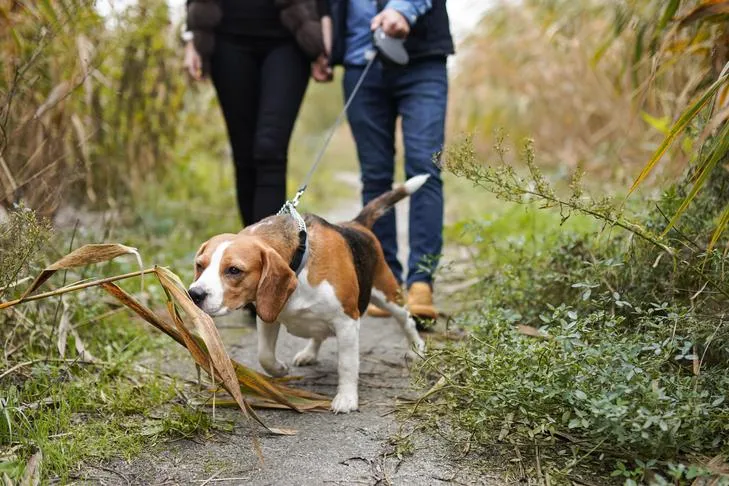Walking your dog should be an enjoyable experience, a time for both of you to get fresh air and exercise. However, for many dog owners, walks often turn into a frustrating tug-of-war, with their canine companions pulling relentlessly on the leash. This common issue, where your dog acts more like a sled dog than a walking partner, can not only be tiring but also potentially unsafe, leading to injuries for both you and your pet. Learning How To Stop A Dog From Pulling While Walking is crucial for a harmonious relationship and safe outings.
Leash pulling isn’t just a minor annoyance; it can make walks unpleasant, deterring owners from taking their dogs out as often as they should, which can impact a dog’s physical and mental well-being. Ensuring your dog understands polite leash behavior is key to managing interactions with other dogs and people, and preventing them from running off or getting into trouble. Even experienced trainers at helplines often receive questions about this challenge. While it might seem daunting, there are effective, simple techniques you can employ, alongside adjustments to your own behavior, to transform your walks. By following these 10 expert tips, you’ll soon find yourself enjoying peaceful strolls with a well-behaved dog by your side. For comprehensive guidance on establishing fundamental routines, you might find resources on how to get a female dog to pee outside helpful, as consistency is key in all aspects of dog training.
1. Always Reward Good Leash Behavior
It’s easy to overlook good behavior, especially when you’re focused on preventing unwanted actions. However, dogs are more likely to repeat actions that bring them rewards. When your dog walks politely on a loose leash, be sure to acknowledge and reinforce this desired behavior. Rewards can be anything your dog values, such as a tasty treat, verbal praise, a gentle pet, or even the chance to sniff something interesting. If you only react when your dog pulls, they might learn that pulling is the way to get your attention or achieve their goals.
Always carry treats on your walks, or be ready with enthusiastic praise and gentle pats. In the initial stages of teaching your dog how to stop pulling while walking, reward them frequently and generously for keeping a slack leash. As their skills improve and they consistently walk without pulling, you can gradually reduce the food rewards and substitute them with “life rewards” like the opportunity to sniff a tree or greet another dog (if appropriate). This positive reinforcement builds a strong foundation for polite leash walking. Understanding how to use rewards effectively is also vital in other areas of development, such as potty training a 12 week old puppy, where consistent positive reinforcement is crucial for success.
2. Never Let Your Dog Walk When They Are Pulling
The primary reason dogs pull is to get to where they want to go faster. If you allow your dog to continue moving forward while they are pulling, you are inadvertently rewarding the very behavior you want to stop. Dogs associate forward movement with pulling, reinforcing the idea that this tactic works. To effectively teach your dog how to stop a dog from pulling while walking, you must remove this reward.
As soon as your dog begins to pull on the leash, stop immediately. Plant your feet firmly and become a “tree.” Do not move forward until the tension on the leash slackens. Your dog will eventually stop pulling, turn to see why you’ve stopped, or simply loosen the leash. This teaches them that pulling achieves the opposite of what they desire – it brings the walk to a halt.
 Two Basenjis meet in a grassy field outdoors, one on a leash.
Two Basenjis meet in a grassy field outdoors, one on a leash.
3. Wait for a Loose Leash Before You Walk
The key to restarting your walk after a stop-and-go is to wait for a loose leash. The leash should hang in a relaxed “J” shape, indicating there is no tension. Additionally, your dog should ideally turn their attention back to you, perhaps with a glance or by reorienting their body towards you. This moment of disengagement from pulling and re-engagement with you is the signal to continue.
Initially, this process might take time and patience. Your dog might be confused about why the walk has stopped. However, with consistent practice, they will begin to understand that a loose leash and your attention are the prerequisites for forward movement. As soon as you see that slack in the leash and a look from your dog, offer praise and a treat at your side, then calmly resume walking. You might find yourself stopping and starting every few steps at first, but your dog will quickly learn that polite walking allows the adventure to continue, while pulling brings it to an immediate halt. This method effectively communicates the desired behavior without harsh corrections.
4. Incorporate Life Rewards on Your Walk
Walks are much more than just potty breaks for your dog; they are vital for physical exercise and mental enrichment. When you are focused on teaching your dog how to stop pulling while walking, it can sometimes feel like these enrichment opportunities are put on hold. To enhance training and make walks more rewarding, integrate “life rewards” for good behavior. Life rewards are the everyday things your dog naturally enjoys, such as the chance to sniff a patch of grass, investigate a fire hydrant, or calmly greet a friendly person.
For example, if your dog walks politely for a stretch of 10-20 feet without pulling, release them with a verbal cue like “Go sniff!” to explore an interesting smell for a few minutes. This reinforces the idea that good behavior leads to enjoyable experiences. These bonus rewards are powerful motivators, convincing your dog that walking calmly pays off. By making walks a genuinely rewarding experience tied to good leash manners, you solidify their understanding that a loose leash grants them access to the world’s wonders, rather than pulling.
5. Walk at a Good Pace
Often, humans walk at a much slower pace than dogs instinctively prefer. Even small breeds have a faster natural gait than many people, leading dogs to pull simply because they want to move more quickly. To help your dog feel more engaged and less inclined to pull, try to maintain a brisk, consistent pace that is comfortable for both of you.
While you can certainly teach your dog to match your speed, a slightly quicker pace during training sessions can make it easier for them to learn not to pull. This isn’t about running, but about maintaining momentum that keeps their interest without feeling the need to surge ahead. A steady, purposeful stride can help your dog fall into rhythm with you, reducing the urge to pull and making the process of how to stop a dog from pulling while walking much smoother.
6. Be Consistent With Your No-Pulling Rule
Consistency is paramount in all aspects of dog training, and teaching your dog how to stop pulling while walking is no exception. It can be incredibly tempting to let your dog pull when you’re in a rush, perhaps running late for an appointment, or when the weather is unpleasant and you just want to get the walk over with quickly. However, every single time you allow your dog to pull, you are reinforcing the unwanted behavior and setting your training progress back significantly.
Regardless of the circumstances, you must be unwavering with your “no-pulling” rule. If you allow pulling even occasionally, your dog learns that sometimes it works, making them more likely to try again. Until your dog reliably walks on a loose leash for a reasonable distance, consider limiting walks to times when you have ample time to dedicate to training. For quick potty breaks, use the yard or a nearby curb, saving dedicated walks for when you can consistently enforce your rules. This steadfast approach is similar to the discipline required for commands like how to train dog to potty on command, where clear and consistent expectations yield the best results.
 A Beagle pulls on a leash, sniffing the ground during an outdoor walk.
A Beagle pulls on a leash, sniffing the ground during an outdoor walk.
7. Keep Training Sessions Short and Fun
Training a dog who is a determined leash puller can be frustrating and exhausting. You might find that in the beginning, you barely make it past your driveway. Instead of pushing your dog (and yourself) to the point of annoyance or discouragement, keep your training sessions brief, positive, and enjoyable. Overly long or demanding sessions can lead to burnout for both you and your dog, making them less receptive to learning.
Puppies, in particular, have very short attention spans, so asking too much too soon will likely lead to negative results. Remember that your primary goal isn’t to cover a certain distance; it’s to achieve a loose leash, even if that’s just for a few steps or to the nearest lamppost. Ending on a positive note, even after a short burst of good behavior, will make your dog more eager for the next session. This principle applies to all training, including intensive programs like how to house train a dog in 7 days, where breaking down tasks into manageable, positive sessions is vital for success.
8. Be Interesting and Engaging on Walks
For your dog, the world is an incredibly stimulating place, filled with captivating sights, sounds, and, most importantly, smells. These myriad distractions can easily entice them to pull you down the sidewalk. If you are distracted, perhaps on your phone or simply not interacting with your dog, there’s little incentive for them to pay attention to you. To counteract the world’s allure, you need to become the most interesting thing on the walk.
Actively engage with your dog. Talk to them in an upbeat tone, offer sudden changes in direction, or initiate quick training breaks for a game of “find it” with a treat. Keep them guessing about what you’ll do next. This level of engagement encourages your dog to focus on you, follow your lead, and be less inclined to pull towards every new stimulus. A dog who is actively partnered with you is far less likely to ignore you and pull.
9. Stay Calm
Walks can present a variety of emotionally charged situations, from encountering a friendly neighbor to passing a reactive, barking dog. Regardless of whether a situation is exciting or frightening for your dog (or for you), it’s crucial to manage your own emotions. Dogs are incredibly adept at reading human emotions, and your mood can easily transmit down the leash to your dog, either intensifying their excitement or escalating their anxiety.
 A Cavalier King Charles Spaniel sits calmly on a lead outdoors.
A Cavalier King Charles Spaniel sits calmly on a lead outdoors.
To help your dog remain calm and focused, you must stay calm yourself. Projecting a relaxed demeanor shows your dog that there’s nothing to be overly concerned or excited about. A relaxed dog is far more likely to listen to your cues and maintain appropriate leash manners than one who is stressed or overstimulated. If you are stressed, your dog will be too, making it harder for them to learn how to stop a dog from pulling while walking.
10. Engage Your Dog In Distracting Situations
Distractions, such as other dogs, squirrels, or even unfamiliar people, are common triggers for leash pulling. When faced with something exciting or potentially intimidating, your dog might pull forward to investigate or try to bolt in the opposite direction. In these moments, all the training for polite leash manners can seem to vanish.
The key to navigating distractions is to redirect your dog’s focus back to you. Before your dog becomes fixated on the distraction, calmly engage them. Offer high-value treats, play a quick game, or ask for a simple command they know well, like “sit” or a “hand target.” These exercises are straightforward for your dog and will keep them mentally engaged with you as the distraction passes. You can also teach a “watch me” cue to establish eye contact, giving you control over where your dog’s attention is directed. The trick is to be proactive – anticipate potential distractions and engage your dog before they notice, hoping they’ll remain focused on you and barely register the distraction at all. This practice is also invaluable for foundational training like how to train dog to potty on command, where maintaining focus under various circumstances is key to reliable behavior.
Learning how to stop a dog from pulling while walking requires patience, consistency, and a positive approach. By implementing these expert tips, you can transform frustrating walks into enjoyable adventures for both you and your canine companion. Remember that every dog is an individual, so adjust these techniques to best suit your dog’s personality and learning style. With dedication, you’ll soon be enjoying peaceful, stress-free strolls, strengthening the bond with your beloved pet. If you encounter persistent challenges or require personalized guidance, seeking advice from certified professional dog trainers can provide invaluable support and tailored solutions.
